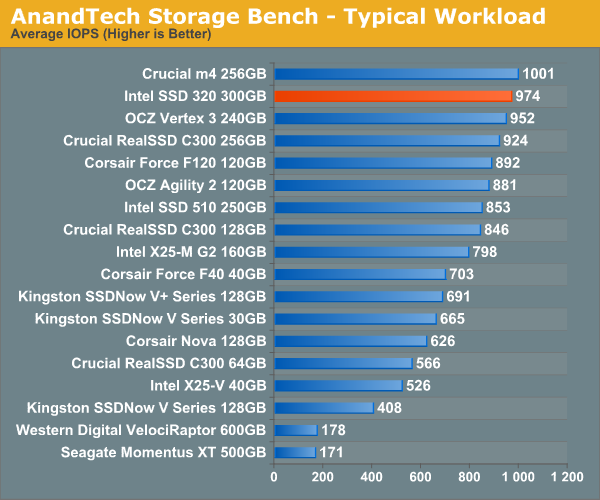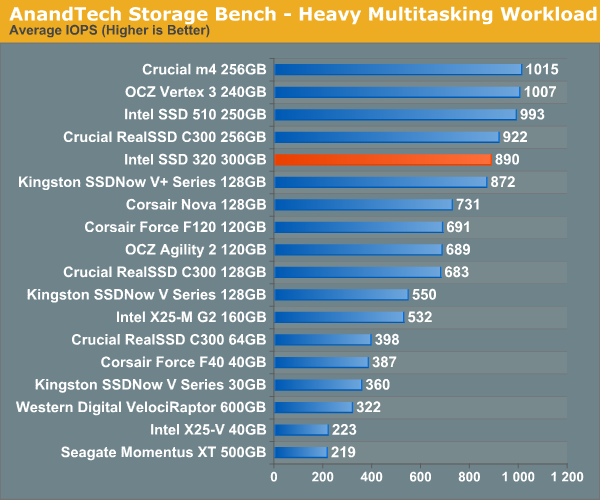The Intel SSD 320 Review: 25nm G3 is Finally Here
by Anand Lal Shimpi on March 28, 2011 11:08 AM EST- Posted in
- IT Computing
- Storage
- SSDs
- Intel
- Intel SSD 320
AnandTech Storage Bench 2010
To keep things consistent we've also included our older Storage Bench. Note that the old storage test system doesn't have a SATA 6Gbps controller, so we only have one result for the 6Gbps drives.
The first in our benchmark suite is a light/typical usage case. The Windows 7 system is loaded with Firefox, Office 2007 and Adobe Reader among other applications. With Firefox we browse web pages like Facebook, AnandTech, Digg and other sites. Outlook is also running and we use it to check emails, create and send a message with a PDF attachment. Adobe Reader is used to view some PDFs. Excel 2007 is used to create a spreadsheet, graphs and save the document. The same goes for Word 2007. We open and step through a presentation in PowerPoint 2007 received as an email attachment before saving it to the desktop. Finally we watch a bit of a Firefly episode in Windows Media Player 11.
There’s some level of multitasking going on here but it’s not unreasonable by any means. Generally the application tasks proceed linearly, with the exception of things like web browsing which may happen in between one of the other tasks.
The recording is played back on all of our drives here today. Remember that we’re isolating disk performance, all we’re doing is playing back every single disk access that happened in that ~5 minute period of usage. The light workload is composed of 37,501 reads and 20,268 writes. Over 30% of the IOs are 4KB, 11% are 16KB, 22% are 32KB and approximately 13% are 64KB in size. Less than 30% of the operations are absolutely sequential in nature. Average queue depth is 6.09 IOs.
The performance results are reported in average I/O Operations per Second (IOPS):

If we strip 6Gbps out of the equation completely, the SSD 320 does very well in our old light workload. You're looking at performance that's at the top of the pack from the mainstream offering.
If there’s a light usage case there’s bound to be a heavy one. In this test we have Microsoft Security Essentials running in the background with real time virus scanning enabled. We also perform a quick scan in the middle of the test. Firefox, Outlook, Excel, Word and Powerpoint are all used the same as they were in the light test. We add Photoshop CS4 to the mix, opening a bunch of 12MP images, editing them, then saving them as highly compressed JPGs for web publishing. Windows 7’s picture viewer is used to view a bunch of pictures on the hard drive. We use 7-zip to create and extract .7z archives. Downloading is also prominently featured in our heavy test; we download large files from the Internet during portions of the benchmark, as well as use uTorrent to grab a couple of torrents. Some of the applications in use are installed during the benchmark, Windows updates are also installed. Towards the end of the test we launch World of Warcraft, play for a few minutes, then delete the folder. This test also takes into account all of the disk accesses that happen while the OS is booting.
The benchmark is 22 minutes long and it consists of 128,895 read operations and 72,411 write operations. Roughly 44% of all IOs were sequential. Approximately 30% of all accesses were 4KB in size, 12% were 16KB in size, 14% were 32KB and 20% were 64KB. Average queue depth was 3.59.

Crank up the workload and the 320 falls a bit behind the rest of the competitors. Last year's heavy multitasking workload is nothing compared to what we introduced earlier this year, so it's still pretty light by comparison but it's clear for normal usage the 320's 3Gbps performance is quite good.
The gaming workload is made up of 75,206 read operations and only 4,592 write operations. Only 20% of the accesses are 4KB in size, nearly 40% are 64KB and 20% are 32KB. A whopping 69% of the IOs are sequential, meaning this is predominantly a sequential read benchmark. The average queue depth is 7.76 IOs.











194 Comments
View All Comments
hackztor - Monday, March 28, 2011 - link
very sad from Intel. Was waiting for these and disappointed. Last gen performance...Price is not very exciting either.Wolfpup - Monday, March 28, 2011 - link
Looks good to me. Intel reliability, FINALLY larger drive sizes + automatic full disk encryption is awesome.Only bad thing is I can't actually find them on Amazon or Newegg yet, and I'd like one for a new system...
vol7ron - Monday, March 28, 2011 - link
You must be blind.This is to the X25-M G2 what Vista was to XP. It's a, "don't buy unless you have to" situation.
OCZ/SandForce have to be laughing - Intel is in shambles. First, SSD delays, then Mobo chipset recalls, then Chandra Anand quits, and now this crap.
Sure, their SSD is still reliable and it's not a bad product, but the pricing isn't even that great. Maybe they don't need to implement the SF-2k series algorithm, but some sort of compression engine would be nice. Claiming powerout reliability is like saying, "we just don't know how to make these capacitors hold a charge." Honestly, I don't care if you have to add a backup NiCad battery. Sure Intel has had reliability down, but they've had over a year to work on speed - this is akin to the Western Digital SSD release; of course it's much more attractive, but it's the reliability vs speed situation.
Who knows, maybe Intel's laughing at us just as hard as OCZ is laughing at them.
Griswold - Tuesday, March 29, 2011 - link
Actually, I'm laughing at you and your nonsense theories. Thanks for that.vol7ron - Tuesday, March 29, 2011 - link
:) a little lite accusations for a comical releaseThermogenic - Tuesday, March 29, 2011 - link
Intel is in shambles? LOL.vol7ron - Tuesday, March 29, 2011 - link
Okay, maybe a little bit of exaggeration, but this wasn't a strong release and they've had their large share of problems lately - don't you think?x86 will have a tough time dealing with RISC. I think RISC is just a better technology, since it doesn't have to deal with legacy instructions. That translates to performances and power efficiencies.
While Intel does still have some room to shrink the die, there isn't much room with current technologies. Also, the ARM chips will continue to decrease in die shrinks as well. That being said, there was some evidence that there could be a cheap alternative to Silicon on the horizon, which would allow for smaller theoretical components. (http://www.dailytech.com/Researchers+Claim+Molybde...
The way I see it, this is similar to when Intel moved the mem controller of the chipset and onto the die. They could have done it sooner, but they are good at extracting $$ from their customers. They reached the high clock rate track and had re-think their position.
While Intel may not be in shambles per se, in its current state, Intel has dished out a lot of debt, they haven't done too well with their NVidia relationship, and they're struggling in the mobile space. And I think AMD is still the better choice on the server front, if I recall correctly. This is all going on while their CEO is on the Obama's Job Council, which I still say that was probably not the best decision.
So, for a company that's been ahead for the last few years, they still have some short-term capabilities, but it's the long term that's important. They need to be successful in breaking into and building a new market segment (Mobile/HTPCs/SSDs).
Wiggy McShades - Tuesday, April 5, 2011 - link
Right now intel has to at very least TRY to hold on to x86 because they only have one competitor in this area, a competitor is severely limited compared to intel, which means huge profits. Intel could easily license the arm architecture and produce an soc that'd blow the everything out of the water. The reason I'm saying this is their manufacturing capabilities are the best in the world which means a LOT for producing microprocessors and currently their cpu's are just a RISC design that translates x86 instructions, so they'd really not even have to hire new engineers. Although then that means a loss in confidence in x86 and could lead to a transition to the arm architecture which they don't control. They probably know x86 isn't going to make it forever, but holding on to it for now is extremely profitable. We'll see how crafty they can get in shoehorning x86 into the mobile arena and that should truly decide how much longer x86 will be around. Intel can easily stand on their manufacturing capabilities and the insanely talented engineers they employ to compete in any up and coming markets, but it's just in their best interest to try and keep x86 dominance for now.FunBunny2 - Saturday, January 14, 2012 - link
Just re-reading, and Intel hasn't built a X86 chip with the instruction set in hardware in more than a decade. There chips are RISC with a X86 suit.piroroadkill - Friday, July 5, 2013 - link
Haha, it's fun reading these old comments, this is one so ill-conceived it makes me laugh.I have an Intel 320 120GB and it still works perfectly. Same can't be said for the OCZ Vertex 2 it replaced, and of course, we all know what happened to OCZ and partly Sandforce's reputation..